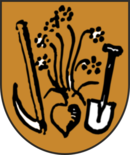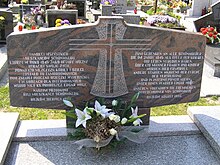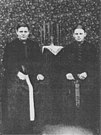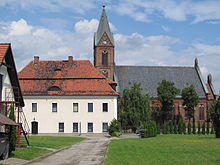Bojków
| Gliwice-Bojków Gleiwitz-Schönwald |
||
|---|---|---|
 Help on coat of arms |
|
|
| Basic data | ||
| State : | Poland | |
| Voivodeship : | Silesia | |
| Powiat : | District-free city | |
| District of: | Gliwice | |
| Geographic location : | 50 ° 15 ' N , 18 ° 41' E | |
| Residents : | ||
Bojków (German: Schönwald , Schönwälder dialect: Schewaude or Šẹwaldẹ, Schlonsakisch: Szywołd ) is a district of Gliwice (Gleiwitz). Also called Szywołd by the inhabitants of the surrounding towns . Bojków is located in the south of Gliwice and consists of the districts Bojków Dolny (Niederdorf), Bojków Środkowy (center) and Bojków Górny (Oberdorf).
history
The place originated in the 13th century at the latest and was first mentioned in 1263 as Sconualde . In 1283 it was mentioned as Scuenevalde , in 1482 as Schonwald and in 1487 as Ssynwaldie . The founders of Schönwald are said to have originally come from Meissen in Saxony and are said to have immigrated to Silesia under Duke Casimir around 1223 . They settled on the grounds of the Rauden monastery . German colonists in Schönwald have been handed down as early as 1263, whose Middle High German dialect, unlike other places in the area, was not Slavicized in the 16th century, which is why the Schönwald, Silesian and German dialect has been preserved as an island of languages . The residents lived u. a. a long time from wagoning. The carriage keeping in Schönwalde flourished until the middle of the 19th century. With the construction of railways this trade died.
The place was mentioned in 1783 in the book Beytrage describing Silesia as Schönwalde , was in the Tost district of the Principality of Opole and had 802 inhabitants, two farms, 61 farmers, some gardeners, 50 cottagers and a Catholic church, a school and a few parsonages. The place was owned by the monastery Rauden . In 1818 the place was mentioned as Schönwalde . After the Rauden monastery was dissolved, the village came into the possession of the Prince Elector of Hesse-Kassel in 1811, to the Landgrave of Hesse-Rothenburg in 1820 and again to Duke Victor von Hohenlohe-Waldenburg in 1834. In 1861 Schönwald had 63 outside farmers, 43 outdoor gardeners or half-farmers, 155 free housekeepers and 86 landowners, and in 1865 a baker, a butcher, five blacksmiths, two wheelwright, five tailors, five shoemakers, a carpenter and a buttman.
In the referendum in Upper Silesia on March 20, 1921, 2219 people eligible to vote in town voted for Upper Silesia to remain with Germany and 35 for membership in Poland. After the division of Upper Silesia, Schönwald remained with the German Empire . In 1935 a film team in Schönwald documented a recreated Schönwald wedding on behalf of the Reich Chamber of Culture for a school film. The approximately 12-minute black and white film by the Puchstein-Film company with the title “A wedding in Schönwald in Upper Silesia” was produced for the “Reich Office for Educational Films”. Until 1945 the place was in the district of Tost-Gleiwitz .
When the Red Army marched into Schönwald in January 1945, there was a massacre of the German population in which more than 120 Schönwald residents were murdered. In the following months the population of Schönwald was expelled. Other beautiful forests perished in flight and displacement and in internment camps. Among these was the pastor of Schönwald Edgar Wolf (1882–1945). In March 1945 the formerly German town came under Polish administration and was then attached to the Silesian Voivodeship and renamed the Polish Bojków . The current Polish name is derived from the old name of the forest, which was called Boycowo or Bojcou and in which Schönwald was abandoned in 1269 by the Rauden monastery. From 1945 to 1954 Bojków was the seat of the Bojków Municipality, from 1954 to 1972 the seat of the Gromada Bojków . After the dissolution of the Silesian Voivodeship, the place became part of the Katowice Voivodeship (from 1953 to 1956 Stalinogród Voivodeship ). In 1975 Bojków was incorporated into Gliwice by the dissolved powiat Gliwicki . In 1999 the place became part of the new Silesian Voivodeship.
Culture
Schönwald was known for the fact that old traditions were preserved up to the 20th century, which were hardly maintained in the surrounding area. This also included wearing traditional costumes and the beautiful forest embroidery. The Schönwälder built the Schönwälder Stickstube in the old town of Gliwice on what was then Wilhelmstrasse, where they offered their self-made goods for sale.
In the ballroom of the “ Haus Oberschlesien ” hotel in downtown Gliwice there was a mural by the German painter Adolf Münzer from 1928 with the title “The Dance”, which was also called “The Schönwalder Hochzeit”. The scene showed a Schönwalder bridal couple, Kränzel couples and wedding guests in their Schönwalder costume dancing outside.
Buildings and sights
- The Church of the Birth of Mary
- The Johannes Nepomuk Chapel
- The Mother of God of Czestochowa Chapel
- The rectory
- Station building of the former narrow-gauge railway
education
- Elementary School No. 8
traffic
The A4 motorway and Droga krajowa nr 78 runs through Bojków. Bojków has a connection to the A4 with the “Bojków” exit.
Personalities
- Georg Miske (born April 9, 1928 - January 28, 2009 in Leipzig), German weightlifter
- Hubert Gillner (born March 13, 1932), German religious, theologian and educator
- Lothar Reinhard (born July 26, 1938), German politician (SPD) and former member of the Hamburg Parliament
- Helmut Klöpsch (born December 4, 1939), German biathlete
literature
- Konrad Gusinde: Word and custom: Schönwald ; 1912
Web links
Individual evidence
- ↑ a b Konrad Gusinde: Word and Custom: “A forgotten German language island in Polish Upper Silesia: The dialect of Schönwald near Gleiwitz” , M. & H. Marcus, 1911
- ^ Zbigniew Mazur: The German cultural heritage in the Polish western and northern regions
- ^ Journal "Oberschlesien im Bild": Issue 23, 1925
- ↑ Schönwald
- ^ Johann Ernst Tramp: Additions to the Description of Silesia, Volume 2 , Brieg 1783
- ^ Geographical-statistical handbook on Silesia and the county of Glatz, Volume 2 , 1818
- ↑ Felix Triest: Topographisches Handbuch von Oberschlesien , Breslau 1865
- ^ Results of the referendum in Upper Silesia in 1921: Literature , table in digital form
- ^ Konrad Gusinde: Schönwald, contributions to the folklore of a German village in the Polish Upper Silesia . In: Theodor Siebs, Max Hippe (Hrsg.): Word and custom - folklore work . tape 10 . Verlag M. & H. Marcus, Breslau 1912, p. 6 .
- ↑ on the Schönwalder costume: Joseph Klapper: Silesian folklore based on cultural history . Breslau: Ferd. Hirt, 1925, 2nd revised. Aufl. Stuttgart: Brentanoverl., 1952, pp. 70-72
- ↑ Photo of the mural The Dance (Schönwälder Hochzeit)










